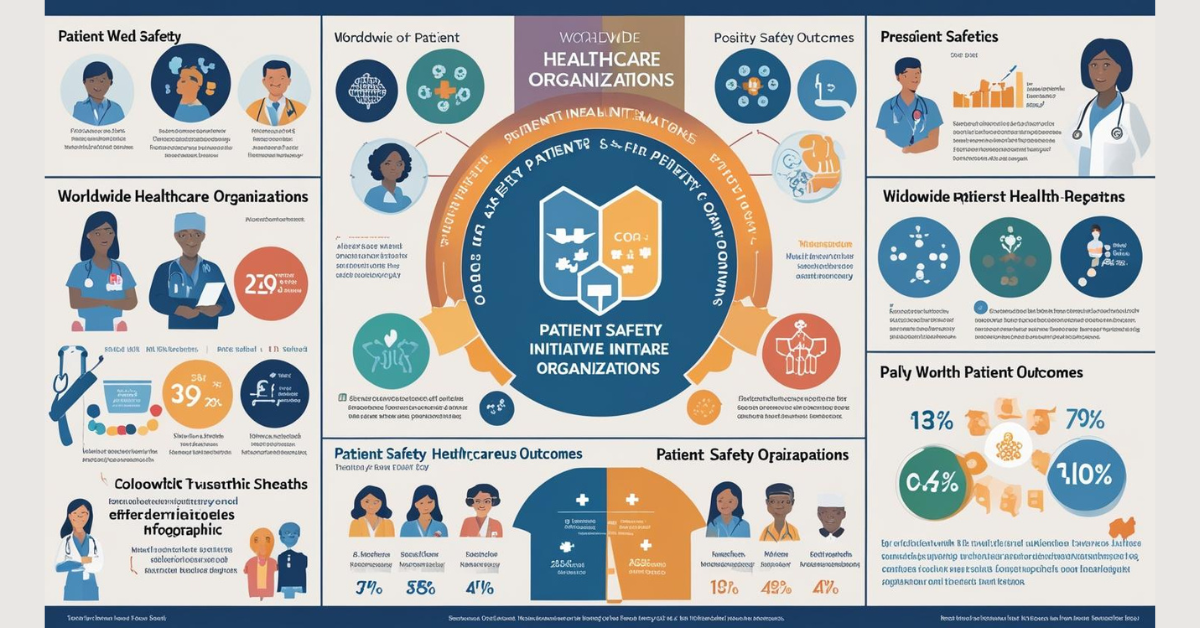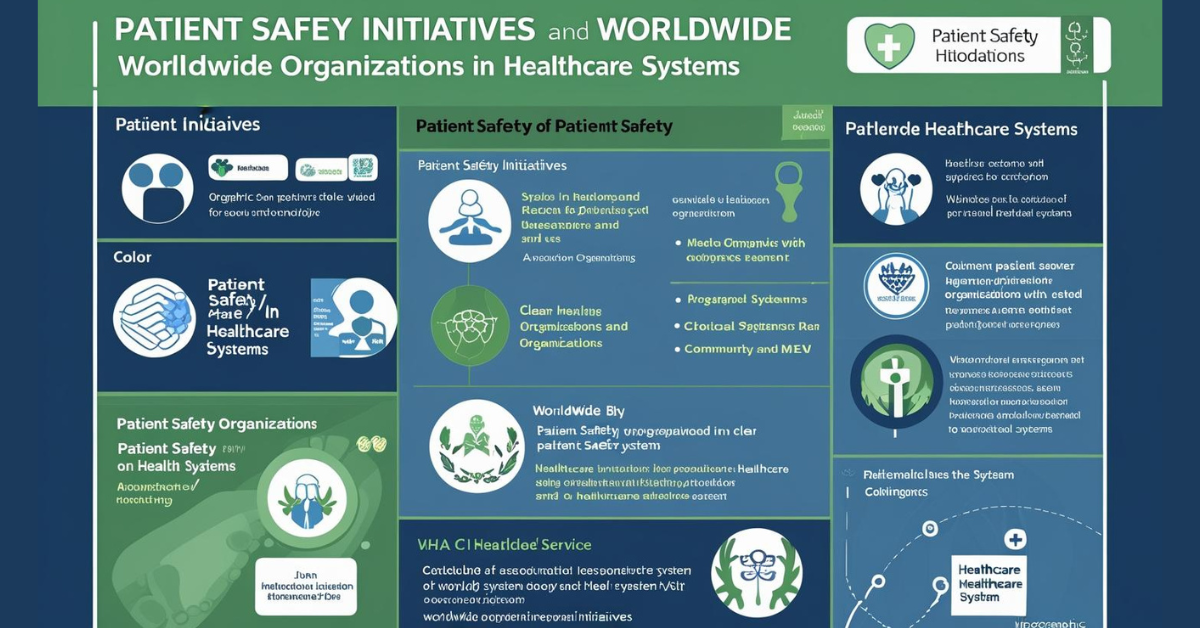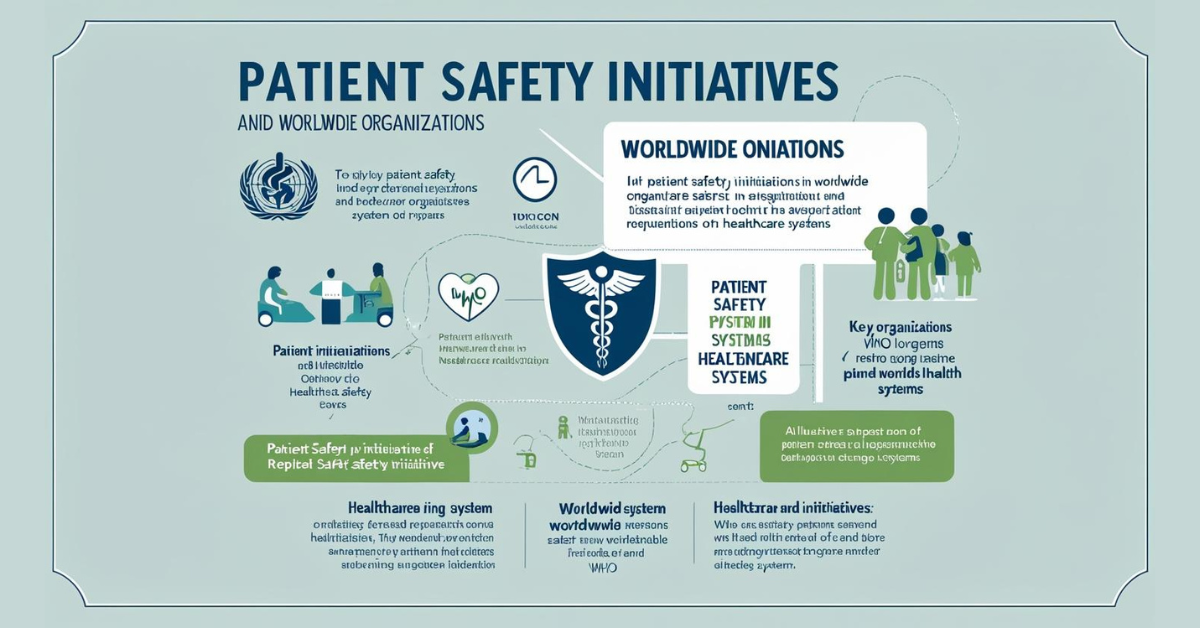The Patient Safety Initiatives and Worldwide Organizations in Healthcare System. Patient safety initiatives are coordinated measures to minimize risk and prevent patient injuries in healthcare settings.
What Is Patient Safety Initiatives and Worldwide Organizations in Healthcare System
Global organizations such as the World Health Organization (WHO) play a critical role in global patient safety by developing frameworks, setting standards, and supporting countries in implementing safety measures. These initiatives seek, among other goals, to promote a culture of safety, improve communication, reduce infections, and ensure the safety of surgical procedures.
Patient Safety Initiatives
Patient safety advocacy groups have emerged since the 1980s in response to concerns about the less than stellar quality of the American health-care system and the prevalence of patient safety concerns. The leaders of many of these groups are people who have had personal experiences with medical errors, thus putting a human face on patient safety issues (Wachter, 2012).
The modern patient safety movement does not call for perfection from our health-care professionals; rather, it acknowledges that humans make errors and replaces the blame-and-shame game with systems thinking (Wachter, 2012). The following are organizations that have put in place safety initiatives that can be used by nurse leaders and managers to promote safe and quality care. All of these patient safety initiatives can positively impact the overall quality of health care.
Agency for Healthcare Research and Quality Established in 1989 as the Agency for Health Care Policy and Research within the Department of Health and Human Services, the Agency for Healthcare Research and Quality (or AHRQ, which it became in 1999) has always had the mission “to make health care safer, higher quality, more accessible, equitable, and affordable” (AHRQ, 2016, para. 1).
In response to the IOM sentinel report To Err Is Human, the AHRQ set out to build a foundation to better understand patient safety. In 2005, the AHRQ established the Patient Safety Network (PSNet), a website featuring essential resources relevant to the patient safety community. Materials are selected for inclusion on the site according to the following criteria (AHRQ, n.d., para. 4):
- Support multidisciplinary, “systems” approach to minimizing errors in health care
- Come from a wide range of disciplines and sources
- Have been written and/or sponsored by credible sources
- Are of interest to the patient safety community at large, both expert and novice
- Are of value for gaining insight into and supporting patient safety
Nurses at all levels can use PSNet to find tips for preventing medical errors and promoting patient safety. Nurse leaders and managers can use PSNet for suggestions about measuring health-care quality as well as accessing consumer assessment of health plans, evaluation software, report tools, and case studies.
American Nurses Association
In 1994, the ANA launched an initiative to investigate the impact of health-care restructuring on the safety and quality of patient care and the nursing profession (Montalvo, 2007). The Patient Safety and Quality Initiative focused on educating registered nurses about quality measurement, informing the public about safe and quality health care, and investigating methods to evaluate the safety and quality of patient care empirically. Through this initiative, strong links between nursing actions and patient outcomes were identified (Montalvo, 2007).
In 1998, the ANA established the National Database of Nursing Quality Indicators (NDNQI), which collects data from participating facilities on 19 nursing-sensitive quality indicators. The NDQI is used by 2,000 hospitals nationwide and reports national comparison information related to nursing-sensitive quality indicators and unit performance. Until recently, the NDNQI was managed by the University Of Kansas School Of Nursing. In 2014, Press Ganey acquired NDQI to offer more specific insights into nursing performance to improve patient experiences and outcomes (Press Ganey, 2014).
Nurse leaders and managers should use these nursing-sensitive quality indicators as part of a comprehensive approach to measuring and evaluating quality of care and assist in improving patient safety. These indicators reflect the characteristics of the nursing workforce, nursing processes, and patient outcomes, which vary according to the characteristics or processes of nursing (Montalvo & Dunton, 2007, p. 1).
In addition, the NDQI also measures characteristics of the nursing workforce that impact the quality of patient care and the patient’s experience such as staffing levels, nurse turnover, and nurse education and certification (Press Ganey, 2014). Nursing-sensitive quality indicators are indicators that reflect elements of patient care that are directly impacted by the quality and quantity of nursing care and include the following:
- Structure indicators relate to the care environment and include staffing levels, hours of nursing care per patient day, nursing skill levels, and education of staff.
- Process indicators relate to how nursing care is provided and include elements falling under the nursing process (i.e., assessment, diagnosis, planning, intervention, and evaluation of nursing care) and job satisfaction.
- Outcome indicators relate to the results of nursing care and include changes in a patient’s health status related to nursing care, such as pressure ulcers and patient falls. Outcome indicators improve when there is greater quality and quantity of nursing care.
National Quality Forum
The National Quality Forum (NQF) is a nonprofit organization established in 1999 in response to the recommendations from the Advisory Commission on Consumer Protection and Quality in the Health Care Industry (NQF, 2016a). The NQF is com mitted to helping the United States achieve better and affordable care and, ultimately, improving the overall health of Americans (NQF, 2016c). The NQF is involved in the following activities to meet this goal (NQF, 2016c):
- Setting standards for health-care measurements
- Recommending measures for use in payment and public reporting programs
- Identifying and accelerating QI priorities
- Advancing electronic measurement to capture necessary data needed to measure performance
- Providing information and tools to help health-care decision makers One national priority the NQF is focusing on is patient safety. The NQF identifies the following three goals as critical in making health care safer for Americans (NQF, 2016b, para. 2):
- Reduce preventable hospital admissions and readmissions.
- Reduce the incidence of adverse health-care–associated conditions.
- Reduce harm from inappropriate or unnecessary care.
The NQF has endorsed a set of nursing-sensitive quality indicators that have been pivotal to understanding nursing’s influence on patient outcomes as well as promoting a measure for QI. Nurse leaders and managers should consider monitoring and measuring these quality indicators as they strive to create an environment of safe and quality care.
Institute for Healthcare Improvement
The Institute for Healthcare Improvement (IHI) was founded in the late 1980s and is currently a leading innovator in health and health-care improvement in the United States and globally (IHI, 2016a). The IHI collaborates with the health-care improvement community to remove improvement roadblocks and launch innovations that dramatically improve patient care (IHI, 2016b).
The IHI has been responsible for two nationwide initiatives, the 100,000 Lives Campaign and the 5 Million Lives Campaign, which spread best practice changes to thousands of hospitals in the United States. The 100,000 Lives Campaign ran from January 2005 through June 2006, with the goal to reduce morbidity and mortality significantly in the American health-care system. The IHI called on hospitals and health-care providers to implement the following interventions to reduce harm and death from medical error (IHI, 2016e, para 3):
- Deploy rapid response teams to patients at risk of cardiac or respiratory arrest.
- Deliver reliable, evidence-based care to patients with myocardial infarctions to prevent deaths from heart attacks.
- Prevent adverse drug events through medication reconciliation, a process of com paring the patient’s list of medications with those ordered by health-care providers on admission, transfer, and/or discharge.
- Prevent central line infections by implementing a series of evidence-based steps called the “Central Line Bundle.”
- Prevent surgical site infections by administering the appropriate preoperative antibiotics and at the proper time.
- Prevent ventilator-associated pneumonia by implementing a series of evidence based steps called the “Ventilator Bundle.” The IHI estimated that more than 2,000 hospitals made a commitment to implement the interventions to reduce harm, and 122,300 lives were saved during the 18-month campaign (IHI, 2016e; Saver, 2006).
The 5 Million Lives Campaign ran from December 2006 through December 2009. The goal was to reduce illness or medical harm, such as adverse events and surgical complications, and patient mortality significantly. The IHI encouraged hospitals and health-care providers to continue the efforts begun in the 100,000 Lives Campaign, which nurse leaders and managers should do, as well as employ the following additional strategies to reduce harm and death from medical errors (IHI, 2016e, para 2):
- Prevent pressure ulcers by using evidence-based guidelines.
- Reduce methicillin-resistant Staphylococcus aureus (MRSA) through basic changes in infection control processes throughout hospitals.
- Prevent harm from high-alert medications with a focus on anticoagulants, sedatives, narcotics, and insulin.
- Reduce surgical complications by reliably implementing changes in care identified by the Surgical Care Improvement Project.
- Deliver evidence-based care to patients with congestive heart failure to reduce readmissions.
- Get hospital boards on board by defining and spreading new processes to encourage boards of directors to be more effective in the improvement of care.
At the close of the campaign, 4,050 hospitals were enrolled, reflecting an unprecedented commitment to patient safety and quality. The IHI believes that the campaign resulted in a massive reduction of patient injuries and tremendous improvement in patient outcomes, “with more than 2,000 facilities pursuing each of the Campaign’s 12 interventions to reduce infection, surgical complication, medication errors, and other forms of unreliable care in facilities. Eight states enrolled 100% of their hospitals in the Campaign, and 18 states enrolled over 90% of their hospitals in the Campaign” (IHI, 2016e, para 10). The IHI emphasizes that a national study is needed to determine whether 5 million instances of harm were prevented as a result of the campaign (IHI, 2016e).
The Joint Commission
TJC, a nonprofit organization founded in 1951, accredits and certifies approximately 20,000 health-care organizations in the United States based on established standards (TJC, 2016b). TJC is involved in numerous activities to ensure that patients “experience the safest, highest quality, best-valued health care across all settings” (TJCs, 2016b). Its mission is to “continuously improve health care for the public, in collaboration with other stakeholders, by evaluating health-care organizations and inspiring them to excel in providing safe and effective care of the highest quality and value” (TJC, 2016b, para 2).
In support of its mission, TJC reviews agency activities in response to sentinel events. TJC is committed to patient safety through initiatives including its Speak Up programs. TJC worked with the Centers for Medicare and Medicaid to launch the Speak Up programs in 2002 with the goal of urging patients to take an active role in preventing medical errors by becoming informed participants in their care. Speak Up encourages health-care consumers to do the following (TJC, 2016c):
- Speak up if you have questions or concerns. If you still do not understand, ask again. It is your body, and you have a right to know.
- Pay attention to the care you get. Always make sure you are getting the right treatments and medicines by the right health-care professionals. Do not assume anything.
- Educate yourself about your illness: Learn about the medical tests you have and your treatment plan.
- Ask a trusted family member or friend to be your advocate (advisor or supporter).
- Know what medicines you take and why you take them. Medicine errors are the most common health-care mistake.
- Use a hospital, clinic, surgery center, or other type of health-care organization that has been carefully checked out.
- Participate in all decisions about your treatment: You are the center of the health care team.
The Speak Up programs include free brochures, posters, and videos available at www.jointcommission.org/speakup.aspx. The Speak Up programs are very successful at promoting increased communication with both patients and staff about safety. Nurse leaders and managers should promote the Speak Up programs by including information about them in unit meetings and staff orientation. As advocates, nurse leaders and managers should assist patients and their families with obtaining information about Speak Up programs.
TJC also established the National Patient Safety Goals (NPSGs) program in 2002 to assist health-care organizations address patient safety concerns. A panel of patient safety experts works with TJC to identify emerging patient safety issues and strategies to best address these issues. The first set of NPSGs became effective in January 2003 and are still updated annually (TJC, 2016d). Nurse leaders and managers can keep up with the NPSGs, which address specific clinical areas such as ambulatory health care, behavioral health care, critical access hospitals, home care, hospitals, laboratory services, long-term care, and office-based surgery.
World Health Organization
WHO member states agreed on a resolution on patient safety in 2002 and recognized patient safety as a global health-care issue in 2004. Believing that every patient should receive “safe health care, every time, everywhere,” the WHO launched the Patient Safety Programmed in 2004. The WHO defines patient safety as “the absence of preventable harm to a patient during the process of health care” (WHO, 2016, para 3). In 2006, the WHO launched the High 5s Project to address major concerns about patient safety globally.
The project derived its name from the WHO’s goals to reduce the frequency of five patient safety problems in five countries over 5 years (WHO, 2014b, p. 9). The goals of the High 5s Project were to use standardization across multicounty settings and to use a multipronged approach to evaluating the standard operating protocols (WHO, 2014b). Five standard operating protocols and associated evaluation instruments were developed between 2007 and 2014 to address the following issues (WHO, 2014b, p. 17):
- Medication accuracy at transitions in care
- Correct procedure at the correct body site
- Use of concentrated injectable medicines
- Communication during patient care handovers
- Health-care–associated infections
The first two standard operating protocols have been implemented by all countries participating in the High 5s Project, including the United States. Nurses at all levels should be aware of these patient safety initiatives and their impact on best practices and safe, quality nursing care. Nurse leaders and managers must embrace patient safety initiatives as they establish a work environment that fosters safe, quality care delivery.
Read More:
https://nurseseducator.com/didactic-and-dialectic-teaching-rationale-for-team-based-learning/
https://nurseseducator.com/high-fidelity-simulation-use-in-nursing-education/
First NCLEX Exam Center In Pakistan From Lahore (Mall of Lahore) to the Global Nursing
Categories of Journals: W, X, Y and Z Category Journal In Nursing Education
AI in Healthcare Content Creation: A Double-Edged Sword and Scary
Social Links:
https://www.facebook.com/nurseseducator/
https://www.instagram.com/nurseseducator/
https://www.pinterest.com/NursesEducator/
https://www.linkedin.com/in/nurseseducator/
https://www.researchgate.net/profile/Afza-Lal-Din
https://scholar.google.com/citations?hl=en&user=F0XY9vQAAAAJ



Hmm is anyone else experiencing problemns with the piictures on thhis
bpog loading? I’m trying to find out if its a prblem on my end orr if it’s the blog.
Any suggestions would be greatly appreciated. https://yv6bg.Mssg.me/